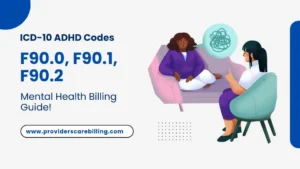In the world of mental health billing, the accuracy of your claims determines timely reimbursement and compliance. Understanding CPT and ICD-10 Codes for Mental Health Billing is essential because these two coding systems define how mental health services are documented. The first one is the Current Procedural Terminology (CPT) system, and the other is the International Classification of Diseases (ICD-10) coding method.
The CPT shows the types of services being provided, and the ICD explains the reason behind such services. If you know how to use both sets of codes correctly, you can reduce denials and improve your practice’s financial health.
To deeply learn about them, stay on this blog post!
What are CPT Codes in Mental Health?
CPT codes are a set of digits created by the American Medical Association (AMA) for medical services and procedures. In mental health billing, CPT codes specifically describe the services that will be provided during a therapy session or behavioral health treatment. Billers can never ignore these codes in detailing the nature of the service being provided to the patient.
The codes are given according to the conditions of a patient and the length of the session. Let’s suppose that you select CPT code 90837 as a 60-minute psychotherapy session. The therapist will match this code with the appropriate documentation so that the insurance claim shows the full service given.
To learn more about how coding fits into billing overall, you can also check our Medical Billing Services page.
The perfect use of the CPT code for behavioral health helps you meet the payer expectations without any chances of denials.
What are ICD-10 Codes and Why Do They Matter?
In fact, CPT codes denote procedures done in the course of treatment, whereas ICD-10 codes show the underlying causes of choosing that service. In simple terms, ICD-10 codes are diagnosis codes, which are used to explain the situation of a patient, disease, or any other health issue. The World Health Organization (WHO) is the source of these codes, which are used in the USA as part of the ICD-10-CM system.
In medical billing, it is necessary to perfectly correspond each CPT code with a correct ICD-10 code to show that the treatment was medically necessary. As an example, a psychotherapy session of 45 minutes with a CPT code of 90834 will appropriately align with an ICD-10 code of F41.1 of Generalized Anxiety Disorder. It makes sure that the service provided is medically necessary and ensures that you are reimbursed perfectly and in a timely manner.
For official details, you can refer to the CDC’s ICD-10-CM guidelines.
CPT and ICD-10: What is the Difference?
As we have already discussed, the main difference in CPT and ICD-10 Codes for Mental Health Billing is that CPT codes explain “what was done,” while ICD-10 codes describe “why it was done.”
The CPT Codes for Mental Health
The procedure or treatment being done is included in CPT codes. Some examples of mental health are:
- 90832 – Psychotherapy for 30 30-minute sessions
- 90834 – Psychotherapy for 45 minutes
- 90837 – Psychotherapy for 60 minutes
- 99484 – General behavioral health integration
For a complete guide on therapist billing, don’t miss our blog on Mental Health Billing for Therapists.
The ICD-10 Codes for Mental Health
The patient’s diagnosis or the reason for selection of specific treatment are involved in ICD-10 Codes; for example:
- F32.1 – Major Depressive Disorder, Mild
- F33.1 – Periodic Depressive Disorder
- F41.1 – General Anxiety Disorder
To understand how these codes apply when billing insurance, visit: How to Bill Insurance as a Mental Health Counselor.
To submit a clean claim, you must correctly choose and connect both the CPT and ICD-10 codes. This is a key part of CPT and ICD-10 Codes for Mental Health Billing. For example, if you use CPT code 90834 but fail to link it with an appropriate ICD-10 diagnosis code, the claim will likely be denied. Proper code pairing is essential for preventing rejections and ensuring timely reimbursement.
Common CPT Codes for Mental Health Services
A broad set of CPT codes to cover mental health is discussed above. The following are other common codes, except for those listed below.
- 99492 or 99493 for Collaborative Care management
- 90791 for Initial psychiatric diagnostic evaluation
The task of choosing the appropriate CPT code is not a one-step process. There are a lot of considerable factors, including the time of the session, the type of services offered, and the kind of provider.
Best Practice Steps for Accurate Coding
If you want to know the accuracy and compliance of your claim, you should follow these best practice steps in medical health billing:
Step 1: Verify the Patient’s Diagnosis (ICD-10) Code
The first step is the most important as you’re starting the coding process. During this, you make sure that you have the right ICD-10 code related to the patient’s condition. It will help you relate the appropriate CPT code.
Step 2: Choose the Proper CPT Code
In the second step, you have to select the CPT code. However, its selection is primarily based on the type of service offered and the time of the session. But one thing you should be very careful of is avoiding mistakes regarding the selection process.
Step 3: Document the Service Properly
The proper documentation is key to successful billing. Therefore, you should be very conscious of taking notes so that they contain all types of sessions, such as treatment approach, how the progress is made, and much more.
Step 4: Link the ICD-10 to the CPT
Now comes the fourth step, which involves linking the ICD-10 diagnosis code to the CPT code. This connection is a crucial part of CPT and ICD-10 Codes for Mental Health Billing, as proper linking helps demonstrate the medical necessity of the service. When the diagnosis and procedure codes align correctly, it supports clean claim submission and reduces the chances of denial.
If you need help with accurate code selection, explore our Medical Coding Services.
Step 5: Stay Updated on Behavioral Health Billing Guidelines
Do not forget that almost every payer is familiar with specific billing rules for behavioural health services. So, we advise you to remain alert and watch out for any alteration to these guidelines to prevent future mistakes and rejections.
By following all these steps, you will not have a chance of claim refusals, and the revenue collection cycle of your practice will be better than ever.
Final Thoughts!
To conclude, successful mental health billing depends on accurate coding that ensures services are billed correctly and practices get reimbursed on time. When you fully understand CPT and ICD-10 Codes for Mental Health Billing and how they link together, you can avoid denials and streamline your entire billing process. As a result, your practice’s revenue cycle becomes smoother and more efficient.
If you need professional help with billing, feel free to contact our team for expert assistance.
FAQS
What is a CPT Code for Mental Health?
The CPT code for mental health is a specific type of code that deals with the nature of therapy and the duration of psychological services.
What are the ICD-10 Codes for Mental Health?
Here are the four most commonly used ICD-10 codes for mental health:
- F32.1 – This code is for mild Major Depressive Disorder
- F33.1 – Recurrent Depressive Disorder
- F41.1 – Generalized Anxiety Disorder
- F90.2 – ADHD with Conduct Disorder
Should I Bill 90837 or 90834?
The code 90834 is for 45-minute psychotherapy sessions. And code 90837 is for 53-minute psychotherapy sessions or longer. But it usually depends on your choice which session you require.
What is a 99214 in Psychiatry?
In psychiatry, CPT 99214 is applied only when there is a need to make an assessment of a patient’s psychiatry. It is used preferably when the patient is of moderate complexity and frequently includes medication-related measures and reviews.
What is the Description for the 99484 CPT Code?
The 99484 CPT code is applicable for general behavioural health integration that requires a larger care management strategy. For this purpose, there should also be coordination with other healthcare providers to oversee the behavioural health needs of a patient.



